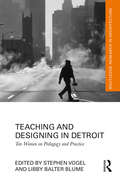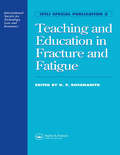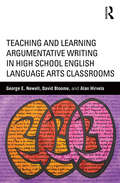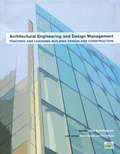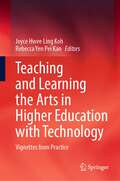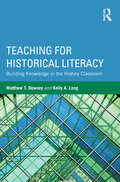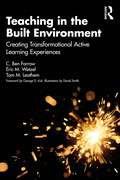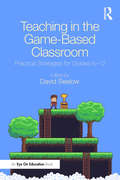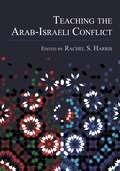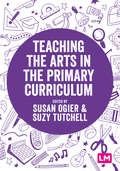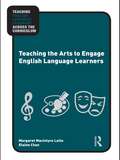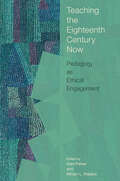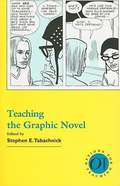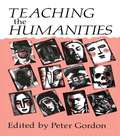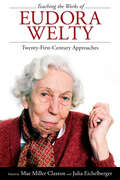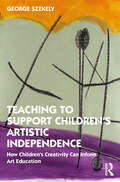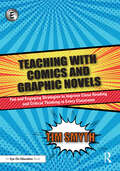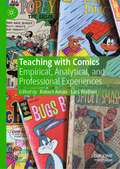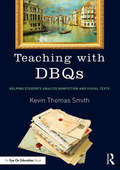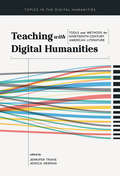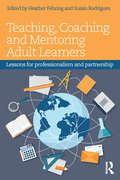- Table View
- List View
Teaching and Designing in Detroit: Ten Women on Pedagogy and Practice (Routledge Research in Architecture)
by Stephen Vogel Libby Balter BlumeThis book provides a compelling and insightful portrait of ten female architects, artists, and designers who explored unique approaches to teaching, practice, and research in the postindustrial city of Detroit. These women explored the phenomenon of a new “ecological urbanism” through their own work in art, architecture, design, planning, landscape architecture, and installation as well as the work of their students. Teaching and Designing in Detroit provides an eighteen-year snapshot of this work, how it affected the women’s practice, how they influenced student relationships to design and community development, and how their visions are now being carried out in Detroit. This book is organized into sections that group stories according to their focus on practice, pedagogy, and community engagement. Included in the book is a foreword by Leslie Kanes Weisman, the only female architecture professor at the University of Detroit Mercy in the 1970s, and an afterword by Sharon Egretta Sutton reflecting on how working and practicing in Detroit foreshadowed the future vision now being carried out in the rebounding city of Detroit. An intriguing read for students and professionals, this book will illustrate how these lessons learned can be applied by universities and communities in other postindustrial cities.
Teaching and Education in Fracture and Fatigue
by H. P. RossmanithThis proceedings contains the best contributions to the series of seminars held in Vienna (1992), Miskolc, Hungary (1993 and 1994) and Vienna (1995) and provides a valuable resource for those concerned with the teaching of fracture and fatigue. It presents a wide range of approaches relevant to course and curriculum development. It is aimed particu
Teaching and Learning Argumentative Writing in High School English Language Arts Classrooms
by Alan Hirvela George E. Newell David BloomeFocused on the teaching and learning argumentative writing in grades 9-12, this important contribution to literacy education research and classroom practice offers a new perspective, a set of principled practices, and case studies of excellent teaching. The case studies illustrate teaching and learning argumentative writing as the construction of knowledge and new understandings about experiences, ideas, and texts. Six themes key to teaching argumentative writing as a thoughtful, multi‐leveled practice for deep learning and expression are presented: teaching and learning argumentative writing as social practice, teachers’ epistemological beliefs about argumentative writing, variations in instructional chains, instructional conversations in support of argumentative writing as deep learning and appreciation of multiple perspectives, contextualized analysis of argumentative writing, and the teaching and learning of argumentative writing and the construction of rationalities.
Teaching and Learning Building Design and Construction: Architectural Engineering And Design Management: Teaching And Learning Building Design And Construction (Architectural Engineering and Design Management)
by Vian Ahmed David DowdleInnovation in building design and construction depends on innovative strategies being developed by teachers and practitioners, made available to students and then professionally adopted. Successful transfer of this knowledge relies on appropriate support for both students and academics to ensure the new knowledge is translated into a format appropriate to the learner's current state of understanding, often using a constructivist, student-centred learning approach. This special issue of the journal Architectural Engineering and Design Management examines new strategies to manage effectively a growing number of students and a changing student profile in the built environment sector. Written by international experts in the field, core themes covered include student-centred learning, practice-based learning, good practice and evaluation, and instructional systems design. Several papers are devoted to virtual learning, focusing on e-pedagogy, standardisation, bridging the gap between academia and industry, and virtual learning environments. This peer-reviewed publication will be invaluable reading for lecturers and students on architecture and civil engineering courses, professional architects and engineers, and all interested in T&L, continuing professional development and distance learning in the built environment sector.
Teaching and Learning the Arts in Higher Education with Technology: Vignettes from Practice
by Joyce Hwee Ling Koh Rebecca Yen Pei KanThis book is an inquiry about the possibilities of using technology to support the education of artists within higher education contexts. Even though technology-enhanced learning and teaching may seem incongruent with the long-established studio-based cultures of making and performing, it is increasingly becoming a pivotal point to connect artistes to potential audience and markets. Amidst the COVID-19 pandemic, technology is also the crucial linchpin for educational continuity of student artists. This book explores how technology could enhance the education of artists and designers as they continue to create, make, and add value to life and society through their artistry. It draws upon the experiences of the Nanyang Academy of Fine Arts (NAFA), a pioneering arts institution in Singapore with over 80 years of institutional history. Through 9 vignettes, this book illustrates technology-enhanced pedagogical practices that have been implemented in different artistic learning spaces including classroom, studio, and stage as well as institutional support strategies. With a naturalistic stance, these chapters seek to illuminate realistic pictures of teaching and learning that are being uncovered by artist educators as they sought to integrate technology within teaching practices using available technologies and within the classes that they are teaching. It is hoped that this book will stimulate conversation among artist educators about possible pedagogical models, as well as inform higher arts institutions about the contextual strategies needed to support the creation of technology-enhanced pedagogical practices.
Teaching for Historical Literacy: Building Knowledge in the History Classroom
by Matthew T. Downey Kelly A. LongTeaching for Historical Literacy combines the elements of historical literacy into a coherent instructional framework for teachers. It identifies the role of historical literacy, analyzes its importance in the evolving educational landscape, and details the action steps necessary for teachers to implement its principles throughout a unit. These steps are drawn from the reflections of real teachers, grounded in educational research, and consistent with the Common Core State Standards. The instructional arc formed by authors Matthew T. Downey and Kelly A. Long takes teachers from start to finish, from managing the prior learning of students to developing their metacognition and creating synthesis at the end of a unit of study. It includes introducing topics by creating a conceptual overview, helping students collect and analyze evidence, and engaging students in multiple kinds of learning, including factual, procedural, conceptual, and metacognitive. This book is a must-have resource for teachers and students of teaching interested in improving their instructional skills, building historical literacy, and being at the forefront of the evolving field of history education.
Teaching in the Built Environment: Creating Transformational Active Learning Experiences
by C. Ben Farrow Eric Wetzel Thomas LeathemTeaching in the Built Environment: Creating Transformational Active Learning Experiences offers a blueprint for teaching success from an award-winning team of educators, with classroom-ready strategies for maximizing undergraduate learning in built environment disciplines. Drawing on the authors’ years of experience as education researchers and faculty at one of the nation’s top design and construction schools, this primer empowers instructors to implement high impact teaching practices in any educational setting, from intimate seminars to "mega classes" of hundreds of students. Chapters on internships, study abroad, and field experiences equip faculty with teaching tools guaranteed to work on or off campus. Just as importantly, this book identifies the teaching tactics that don’t work. The authors’ candid reflections on their own failed pedagogical experiments help instructors avoid confidence-shaking missteps and encourage them to turn teaching struggles into future successes. A thorough review of the latest education research provides theoretical context and empirical support for strategies direct from the authors’ award-winning classrooms, studios, and labs. Features: Classroom-tested strategies for maximizing undergraduates’ learning in built environment disciplines Adapted teaching methods from the authors’ award-winning classrooms, studios, and labs to any higher education setting An ideal resource for built environment faculty, from first timers to veteran educators The latest research on teaching and learning in design and construction disciplines A must-read for built environment educators, from first-time faculty to classroom veterans, Teaching in the Built Environment: Creating Transformational Active Learning Experiences inspires teaching that will resonate long past the semester’s end.
Teaching in the Game-Based Classroom: Practical Strategies for Grades 6-12
by David SeelowTeaching in the Game-Based Classroom is a hands-on guide to leveraging students’ embrace of video games toward successful school performance. Evidence tells us that game-based learning can help teachers design classes, develop transformative learning tools, and assess progress on multiple levels not dependent on one-size-fits-all bubble sheets. Authored by game-savvy teachers in partnership with classroom-experienced academics, the highly varied chapters of this book are concise yet filled with sound pedagogical approaches. Middle and high school educators will find engaging new ways of inspiring students’ intrinsic motivation, skill refinement, positive culture-building, autonomy as learners, and more.
Teaching the Arab-Israeli Conflict
by Cary Nelson Peter C. Herman Alan Dowty P. R. Kumaraswamy Joel S. Migdal Liora R. Halperin Philip Metres Caitlin Carenen Jacob Lassner Shiri Goren Rachel S. Harris Ranen Omer-Sherman Amy Weiss Mira Sucharov Umut Uzer Janice W. Fernheimer Martin Shichtman Ashley Passmore Dr Donna R. Divine Adia Mendelson-Maoz Marcela Sulak Ellen W. Kaplan Beverly Bailis Marilyn R. Tayler Randall G. Rogan Oren Kroll-Zeldin Russell A. Berman Shayna Weiss Olga Gershenson Holli Levitsky Terri Susan Fine Husam Mohamad Menna Abukhadra Rachel Feldhay Brenner Jeffrey Bloodworth Ari Ariel Mya Guarnieri Jaradat Susan Jacobowitz Rolin G. Mainuddin Randy DeshazoThe Arab-Israeli conflict has become a touchstone of international politics and a flash point on college campuses. And yet, how do faculty teach such a contentious topic in class? Taught not only in international relations, peace and conflict resolution, politics and history, and Israel and Middle Eastern studies courses but also in literature, sociology, urban planning, law, cinema, fine art, and business—the subject guarantees wide interest among students. Faculty are challenged to deal with the subject’s complexity and the sensitive dynamics it creates. The result is anxiety as they approach the task and a need for guidance. Teaching the Arab-Israeli Conflict edited by Rachel S. Harris is the first book designed to meet this need. Teaching the Arab-Israeli Conflict brings together thirty-nine essays from experienced educators who reflect on the challenges of engaging students in college classrooms. Divided into seven sections, these personal essays cover a broad range of institutional and geographical settings, as well as a wide number of academic disciplines. Some of the topics include using graphic novels and memoirs to wrestle with the complexities of Israel/Palestine, the perils of misreading in the creative writing classroom as border crossing, teaching competing narratives through film, using food to teach the Arab-Israeli conflict, and teaching the subject in the community college classroom. Each essay includes suggestions for class activities, resources, and approaches to effective teaching. Whether planning a new course or searching for new teaching ideas, this collection is an indispensable compendium for anyone teaching the Arab-Israeli conflict.
Teaching the Arts
by William Baker Amy Hamilton David RoyTeaching the Arts: Early Childhood and Primary Education provides a comprehensive and exciting introduction to Arts education in Australia and New Zealand. By illustrating the fundamental links between theory and practice, this book equips students with the skills and knowledge to teach the Arts. The book covers each of the five Arts strands -dance, drama, media arts, music and visual arts - in detail. Each chapter encourages readers to engage with the Arts and provides opportunities to develop understanding and practical skills through reflective questions, examples and activities. Teaching the Arts draws important links to the Australian Curriculum, the New Zealand Curriculum, the Early Years Learning Framework and TeWhariki, and includes substantial references to Indigenous histories and cultures, relationships with Asia, and sustainability. Generously illustrated and featuring excellent on-line resources, Teaching the Arts is an indispensable resource for pre-service teachers.
Teaching the Arts
by William Baker David Roy William Baker Amy Hamilton David RoyTeaching the Arts: Early Childhood and Primary Education provides a comprehensive and exciting introduction to Arts education in Australia and New Zealand. By illustrating the fundamental links between theory and practice, this book equips students with the skills and knowledge to teach the Arts. The book covers each of the five Arts strands -dance, drama, media arts, music and visual arts - in detail. Each chapter encourages readers to engage with the Arts and provides opportunities to develop understanding and practical skills through reflective questions, examples and activities. Teaching the Arts draws important links to the Australian Curriculum, the New Zealand Curriculum, the Early Years Learning Framework and TeWhariki, and includes substantial references to Indigenous histories and cultures, relationships with Asia, and sustainability. Generously illustrated and featuring excellent on-line resources, Teaching the Arts is an indispensable resource for pre-service teachers.
Teaching the Arts in the Primary Curriculum (Exploring the Primary Curriculum)
by Suzy Tutchell Susan OgierLearning in the arts does not fit in with simple, conventional methodologies for teaching and assessing in the traditional sense, but it has an immense power to transform children’s understanding of the world around them, and their lives. Many jobs, currently and of the future, will demand the skills that learning in the arts will develop. This book brings Arts Education sharply into focus as a meaningful, learning experience for children of pre-school and primary age (3-11 years). It reinforces the potential for the wide range of physical, mental and emotional development, through learning opportunities that engagement in arts practice facilitates. Provides insight into how teachers can support children to consider contemporary challenges that face their generation. Includes expert voices from the world of education to demonstrate an expansive, and perhaps surprising, view of where and how the Arts can be found. Shows how we can bring the arts so easily into our curriculum, and into our classrooms.
Teaching the Arts in the Primary Curriculum (Exploring the Primary Curriculum)
by Suzy Tutchell Susan OgierLearning in the arts does not fit in with simple, conventional methodologies for teaching and assessing in the traditional sense, but it has an immense power to transform children’s understanding of the world around them, and their lives. Many jobs, currently and of the future, will demand the skills that learning in the arts will develop. This book brings Arts Education sharply into focus as a meaningful, learning experience for children of pre-school and primary age (3-11 years). It reinforces the potential for the wide range of physical, mental and emotional development, through learning opportunities that engagement in arts practice facilitates. Provides insight into how teachers can support children to consider contemporary challenges that face their generation. Includes expert voices from the world of education to demonstrate an expansive, and perhaps surprising, view of where and how the Arts can be found. Shows how we can bring the arts so easily into our curriculum, and into our classrooms.
Teaching the Arts to Engage English Language Learners
by Margaret Macintyre Latta Elaine ChanWritten for prospective and practicing visual arts, music, drama, and dance educators, Teaching the Arts to Engage English Language Learners offers guidance for engaging ELLs, alongside all learners, through artistic thinking. By paying equal attention to visual art, music, drama, and dance education, this book articulates how arts classrooms can create rich and supportive contexts for ELLs to grow socially, academically, and personally. The making and relating, perceiving and responding, and connecting and understanding processes of artistic thinking, create the terrain for rich curricular experiences. These processes also create the much-needed spaces for ELLs to gain communicative practice, skill, and confidence. Special features include generative texts such as films, poems, and performances that function as springboards for arts educators to adapt according to the needs of their classroom; teaching tips, formative assessment practices, and related instructional tables and resources; an annotated list of internet sites, reader-friendly research articles, and instructional materials; and a glossary for readers’ reference.
Teaching the Eighteenth Century Now: Pedagogy as Ethical Engagement (Transits: Literature, Thought & Culture, 1650-1850)
by Kate Parker Tiffany Potter Diana Epelbaum Teri Doerksen Ziona Kocher Christine D. Myers Matthew L. Reznicek Travis Chi Lau Emily C. Casey Eugenia ZuroskiIn this timely collection, teacher-scholars of “the long eighteenth century,” a Eurocentric time frame from about 1680 to 1832, consider what teaching means in this historical moment: one of attacks on education, a global contagion, and a reckoning with centuries of trauma experienced by Black, Indigenous, and immigrant peoples. Taking up this challenge, each essay highlights the intellectual labor of the classroom, linking textual and cultural materials that fascinate us as researchers with pedagogical approaches that engage contemporary students. Some essays offer practical models for teaching through editing, sensory experience, dialogue, or collaborative projects. Others reframe familiar texts and topics through contemporary approaches, such as the health humanities, disability studies, and decolonial teaching. Throughout, authors reflect on what it is that we do when we teach—how our pedagogies can be more meaningful, more impactful, and more relevant. Published by Bucknell University Press. Distributed worldwide by Rutgers University Press.
Teaching the Graphic Novel
by Stephen E. TabachnickGraphic novels are now appearing in a great variety of courses: composition, literature, drama, popular culture, travel, art, translation. The thirty-four essays in this volume explore issues that the new art form has posed for teachers at the university level.
Teaching the Humanities
by Peter GordonFirst Published in 1991. Routledge is an imprint of Taylor & Francis, an informa company.
Teaching the Works of Eudora Welty: Twenty-First-Century Approaches
by Mae Miller Claxton and Julia EichelbergerContributions by Jacob Agner, Sharon Deykin Baris, Carolyn J. Brown, Lee Anne Bryan, Keith Cartwright, Stuart Christie, Mae Miller Claxton, Virginia Ottley Craighill, David A. Davis, Susan V. Donaldson, Julia Eichelberger, Kevin Eyster, Dolores Flores-Silva, Sarah Gilbreath Ford, Stephen M. Fuller, Dawn Gilchrist, Rebecca L. Harrison, Casey Kayser, Michael Kreyling, Ebony Lumumba, Suzanne Marrs, Pearl Amelia McHaney, David McWhirter, Laura Sloan Patterson, Harriet Pollack, Gary Richards, Christin Marie Taylor, Annette Trefzer, Alec Valentine, Adrienne Akins Warfield, Keri Watson, and Amy WeldonToo often Eudora Welty is known to the general public as Miss Welty, a "perfect lady" who wrote affectionate portraits of her home region. Yet recent scholarship has amply demonstrated a richer complexity. Welty was an innovative artist with cosmopolitan sensibilities and progressive politics, a woman who maintained close friendships with artists and intellectuals throughout the world, a writer as unafraid to experiment as she was to level her pen at the worst human foibles.The essays collected in Teaching the Works of Eudora Welty seek to move Welty beyond a discussion of region and reflect new scholarship that remaps her work onto a larger canvas. The book offers ways to help twenty-first-century readers navigate Welty's challenging and intricate narratives. It provides answers to questions many teachers will have: Why should I study a writer who documents white privilege? Why should I give this "regional" writer space on an already crowded syllabus? Why should I teach Welty if I do not study the South? How can I help my students make sense of her modernist narratives? How can Welty's texts help me teach my students about literary theory, about gender and disability, about cultures and societies with which my students are unfamiliar?
Teaching to Support Children's Artistic Independence: How Children's Creativity Can Inform Art Education
by George SzekelyThis engagingly written, research- and practice-based book defines how art teachers can build on students’ creative initiatives without depending on adult-imposed lesson plans and school requirements. In doing so, art educator and author George Szekely explores the role of the arts in developing children’s creativity and sense of purpose, and reminds readers that students in the art classroom are unique artists, designers, and innovators. Against the backdrop of a school culture that over-emphasizes compliance and standardization, Szekely recognizes the importance of the role of the art teacher in supporting the artistic independence and creative flare that occurs naturally in students of all ages in the classroom. Providing real-life examples of classrooms and schools that work towards championing child artists, this text arms teachers with the skills necessary to listen to their students and support them in presenting their ideas in class. Ultimately, Szekely challenges readers to focus the practice of art teaching on the student’s creative process, rather than the teacher’s presentation of art. Written for pre-service and in-service art educators, teacher educators, and researchers, Teaching to Support Children’s Creativity and Artistic Independence demonstrates that an openness to youthful and inquisitive visual expression inspires a more rewarding learning experience for both teacher and child artists that can support a life-long love of art.
Teaching with Comics and Graphic Novels: Fun and Engaging Strategies to Improve Close Reading and Critical Thinking in Every Classroom
by Tim Smyth35th Annual Will Eisner Comic Industry Awards Nominee! This text will allow you to harness students’ love of comics and graphic novels while increasing critical thinking and engagement in the classroom. Author Tim Smyth offers a wide variety of lessons and ideas for using comics to teach close reading, working with textual evidence, literature adaptations, symbolism and culture, sequencing, essay writing, and more. He also models how to use comics to tackle tough topics and enhance social-emotional learning. Throughout the book, you’ll find a multitude of practical resources, including a variety of lesson plans—some quick and easy activities as well as more detailed ready-to-use unit plans. These thoughtful lessons meet the Common Core State Standards and are easy to adapt for any subject area or grade level to fit into your curriculum. Add this book to your professional library and you’ll have a new and exciting way of reaching and teaching your students!
Teaching with Comics: Empirical, Analytical, and Professional Experiences
by Robert Aman Lars WallnerThis edited collection analyses the use of comics in primary and secondary education. The editors and contributors draw together global research to examine how comics can be used for critical inquiry within schools, and how they can be used within specific disciplines. As comics are beginning to be recognised more widely as an important resource for teaching, with a huge breadth of topics and styles, this interdisciplinary book unites a variety of research to analyse how learning is 'done' with and through comics. The book will be of interest to educational practitioners and school teachers, as well as students and scholars of comic studies, education and social sciences more broadly.
Teaching with DBQs: Helping Students Analyze Nonfiction and Visual Texts
by Kevin Thomas SmithHelp your students navigate complex texts in history and social studies. This book shows you how to use document-based questions, or DBQs, to build student literacy and critical thinking skills while meeting rigorous state standards and preparing students for AP exams. DBQs can be implemented year-round and can be adjusted to meet your instructional needs. With the helpful advice in this book, you’ll learn how to use DBQs to teach nonfiction and visual texts, including primary and secondary sources, maps, and paintings. You’ll also get ideas for teaching students to examine different points of view and write analytical responses. Topics include: Using the SOAPSETone (Speaker, Occasion, Audience, Purpose, Subject, Evidence and Tone) technique to to analyze visual and nonvisual texts; Teaching students to distinguish between primary and secondary sources; Working with multiple texts and learning to recognize the relationships between them; Formulating DBQs to suit different types of assessment, including short-answer questions, multiple-choice questions, and in-class essay prompts; Evaluating student responses and providing constructive feedback.
Teaching with Digital Humanities: Tools and Methods for Nineteenth-Century American Literature (Topics in the Digital Humanities)
by Jennifer Travis Jessica DeSpainJennifer Travis and Jessica DeSpain present a long-overdue collection of theoretical perspectives and case studies aimed at teaching nineteenth-century American literature using digital humanities tools and methods. Scholars foundational to the development of digital humanities join educators who have made digital methods central to their practices. Together they discuss and illustrate how digital pedagogies deepen student learning. The collection's innovative approach allows the works to be read in any order. Dividing the essays into five sections, Travis and DeSpain curate conversations on the value of project-based, collaborative learning; examples of real-world assignments where students combine close, collaborative, and computational reading; how digital humanities aids in the consideration of marginal texts; the ways in which an ethics of care can help students organize artifacts; and how an activist approach affects debates central to the study of difference in the nineteenth century.
Teaching with Vampires (Teaching the New English)
by U. Melissa AnyiwoThis edited volume provides pedagogical tools for those who teach – and would like to teach – with the most iconic of monsters: the vampire. Vampires are showing up with increasing frequency in the college classroom and there are a growing number of courses devoted solely to the Undead. This collection draws from a diverse range of teaching approaches, including the theoretical framing of vampire texts in a broad range of settings, that demonstrate the myriad of ways vampires are used to teach about marginalization, empathy, and inspire social justice. With chapters from global scholars, this essential text illustrates the burgeoning field of vampire studies and the popularity in classrooms at every level around the world, from gothic fiction to television courses.
Teaching, Coaching and Mentoring Adult Learners: Lessons for professionalism and partnership
by Heather Fehring Susan RodriguesThe challenge for those coaching, mentoring, supervising or teaching adults is to design and deliver high-quality programmes that encompass a blend of teaching and learning approaches and strategies, that are constructed for adult learners in multiple educational environments and that cater for the diversity of adult learners’ needs. Adult learners are complex individuals who come to the learning process with a multitude of different experiences. Teaching, Coaching and Mentoring Adult Learners helps practitioners step up to this challenge by developing the skills needed to share their expertise with adult learners and engage them in new transformative practices. This book also forms a timely contribution to the current period of evolution in adult education, where extreme changes in the nature and scope of work and the globalisation of work and life are influencing learning. The shift in adult education addressed in this book includes: the globalisation of the workforce and the cultural impact on adult, tertiary and further education the relationship established between adult educators and adult learners provision of adult education and professional development by private and major multimedia and corporate interests occupations boundaries between professions and between skilled and unskilled work assessing adult learners’ needs and adapting strategies to meet the perceived needs of adult learners in medicine, education, psychology and industry designing learning experiences to maximise the processing of complex conceptual knowledge and then transforming the knowledge to fit new learning environments the role of new technologies of learning in adult and vocational learning. This book provides research-based insight into the expectations and the value of the coach, mentor, tutor and supervisor roles and combines research with strategic guidance to support the implementation of innovative techniques through case studies, strategies and methodologies in teaching and learning in higher education and professional learning. Bringing together insights from an expert range of international contributors, this text will be invaluable to higher education professionals and those involved in supervising, coaching and mentoring in the workforce.
